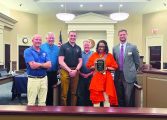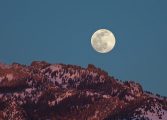By Page H. Gifford
Correspondent
Imagine looking out your window at a beautiful, natural landscape with native plants and water features abundant with birds singing, bees buzzing, and butterflies fluttering. This is a yard created to support wildlife and maintain the natural balance. It is a certified Natural Wildlife Federation yard and some already exist at Lake Monticello.
At the June meeting of the Lake Monticello Board of Directors, by a majority vote, the board approved a proposal that would certify the community by the National Wildlife Federation. The proposal was set forth by the Lake Wildlife Committee to fulfill one of its goals set by the LMOA board regarding “going green.”
“The primary focus of the LM Wildlife Committee is to initiate and implement wildlife education programs, activities and educational materials relevant to wildlife of the LM community, to educate the residents on living in harmony with wildlife. The many benefits to becoming certified by NWF as a Community wildlife Habitat tie in perfectly with this focus,” said Cathy Gibbs who is team leader for the program. “The certification program provides a framework and resources that support communities that want to restore and enhance wildlife habitat. It also supports elements of the LMOA Strategic Plan, to develop a Green Plan that identifies best practices for LMOA and community residents, and develop best practices for residents to attract pollinators.”
This is not the first attempt at preserving the natural environment and wildlife habitat at the Lake. Two years ago, the Wildlife, Golf, and Watershed committees worked together to successfully certify the golf course area through the Audubon certification process.
Under this new program, common areas of the Lake and residential properties can be counted toward community certification. Prior to LMOA approving of community-wide certification, individual properties have been certified since the program has been in existence.
The NWF has been helping people restore habitats since 1973 and certified its first community in 1998. They currently partner with 200 municipalities and communities throughout the U.S. through the Community Wildlife Habitat program. Registered communities are those that have joined their program and are working toward certification with support from the NWF. Certified communities have achieved their certification as a NWF Community Wildlife Habitat and over time maintain their certification. Lake Monticello is now registered and has two years to complete certification. Other areas of Virginia that are registered or certified include Arlington County, Kendal at Lexington, and Roanoke Valley.
This is not a mandatory program and residents can choose to participate. Some question the necessity and believe that going natural means having an overgrown, grubby yard. However, the NWF has guidelines help to create lovely backyard habitats that serve a purpose while following the ECC rules. There are many acceptable components of the NWF certification.
Nowadays, when concern is growing about protecting the environment, communities are choosing to make an effort to do their part to restore and preserve habitats that have been lost to urban sprawl. The benefits include maintaining a sustainability plan which committees like Wildlife and Watershed already support. It builds an environmentally friendly community with residents working together. The Lake already has a Beautification Corps and many master gardeners and naturalists living among the residents.
Twenty years ago, it was required that homes at the Lake remain unobtrusive as possible and blend in with the natural landscape. As time passed, and build-out occurred, ECC policies were changed to accommodate the ever-changing landscape of Lake Monticello. Now, with many being environmentally conscience, the community is looking at combining the best of both worlds.
Beautification can be seen in many forms around the Lake but to have a successful garden that can be natural start with native, deer resistant plants and there are many. Other key elements for certification are trees, even tree stumps, which can be crafted to blend into the natural landscape. Some residents use mulchers to pulverize leaves for natural mulch.
“As part of becoming a certified habitat community the wildlife committee will educate residents about providing for the basic needs of all wildlife, sustainable gardening practices, and conservation efforts. We will offer programs on the use of native plants, water conservation, reduction in the use of chemicals, importance of pollinators, and other topics,” said Gibbs.
Key elements include sustainable gardening practices, encouraging the use of rain barrels for water conservation, removing invasive plants and using native ones, and eliminating pesticides. Water features, like a bird bath or frog pond, can be built as well as bird houses. Cover for protection from weather and predators like tree hollows and underbrush is encouraged. Pollinator loving shrubs with berries, rock walls, evergreens, and butterfly bushes are just a few of the many ideas that can be incorporated into a natural space.
For LM to become certified as a Wildlife Habitat it must have at least 175 individual properties certified with the NWF. The Lake must also accumulate points through education and outreach to the community, by hosting workshops and programs about gardening for wildlife and holding community events such as removing invasive plants and other projects to make the community healthier for people and wildlife alike,” said Gibbs. LM also has other common areas and the golf course, which is Audubon certified, that could be considered for points as well. After certification, each community must earn 30 points toward re-certification.
The process to certify an individual property can be done online or with a paper application and only takes a few minutes and certification only takes a couple of days. It can be done online at www.nwf.org/community, to certify a habitat. Fill out the application along with a one-time fee of $20. Applications will soon be available at the entrance to The Pub or by contacting Cathy Gibbs at cgibbs116@aol.com
“This program will have an impact on the community by bringing together many members that have an interest in wildlife and the natural environment, and want to make LM a healthier and more welcoming community for both the residents and wildlife,” said Gibbs. “By creating habitats for wildlife with native plants, wild flowers, and shrubs, we will be beautifying our community. A healthier lake will result from conservation efforts to prevent runoff. We encourage members to participate in workshops and programs and volunteer to support projects that the wildlife committee might sponsor.”




